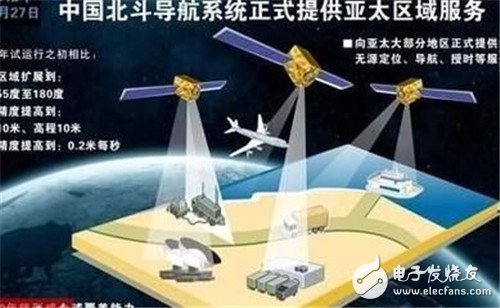At present, there are only four countries (including the European Union) that can develop and put into use the navigation satellite system in the world. In this field, China is the latest to start, but it is also the fastest growing. Now our technology is not only ahead of Europe, but may even become the navigation satellite that is most trusted by other countries in the future.
Military experts said that during the development of China's Beidou system, it has experienced a difficult stage. Because China lacks corresponding technical reserves, the "first generation" effect of Beidou is not ideal. At that time, it was catching up with Europe to engage in Galileo satellite navigation. Satellite navigation is a super-burning job. At that time, the EU wanted to find someone to cooperate.

China is just because the "first generation" of Beidou is not arrogant, it is naturally a hit and promised to invest 300 million euros in "deposits." The EU's subsequent practice is really "not authentic", and it has brought in India and Japan. This not only involves China's share of the Galileo system, but also China's core interests.

Therefore, China finally decided to "single-handedly", but the "deposit" of 300 million euros in Europe considered that China's "default" did not return. At present, when the EU's Galileo satellite navigation is formed is still a distant event, and China's Beidou satellite navigation system has long been put into use.
The first launch of the 2017 "Beidou III" system is scheduled to be completed in July, and several rounds of double-star launch will be implemented. Six to eight satellites are planned to be launched during the year. The "Beidou No.3" system adopts the integrated design of inter-satellite transmission and ground-based transmission, and realizes the link intercommunication between high-rail and low-orbit satellites and ground stations.
According to the previous plan, the Beidou system will complete 18 global satellite launches in 2018 to provide basic services. These 18 satellites are reasonably distributed in orbit. From the mathematical point of view, they have met the requirements of seeing four satellites at the same time in any position in the world. However, considering the constraints such as occlusion, the real global network needs at least 24 satellites like the GPS system. .

China's Beidou navigation system is composed of five geostationary orbit satellites and 30 non-stationary satellites. The Beidou needs to launch three tilt-synchronous orbit satellites. Although these three satellites are not completely stationary with the ground, most of the time, China still has Can see, so it's great to help the system immediately.

China's "Beidou" system
Another reason is that because Beidou works with passive receivers like GPS, there are two unique functions, namely, using active receivers (the receiver actively signals the satellites) and sending and receiving short messages ( Satellite SMS), so 5 geosynchronous orbit satellites are required to be sent for both functions.
If satellite navigation is mentioned, people often think of GPS. Nowadays, people can think more about the domestic Beidou navigation system. Although this system has not started to provide services for a long time, as an emerging navigation system, its function needs to be developed and applied. To be improved, we are full of hope for its future.

China's Beidou system is currently the most advanced satellite navigation system
At present, the Beidou system provides service areas only to the periphery of China. However, since the opening of the service, the operation has been stable and reliable. Last year, the output value of China's satellite navigation industry reached 170 billion yuan, which produced huge social and economic benefits. Its use is definitely not only convenient for our life, but also for military applications. It is necessary to remove the situation of our system, and there are many applications to choose from. Of course, this also makes the opponent not a good thing. The US military has already begun to look for ways to deal with the Beidou system. It is generally divided into two types of means. The soft means are being implemented: 1, dry worry, 2, crack.

China's Beidou system is currently the most advanced satellite navigation system
A few years ago, when the Beidou system was in the test phase, it was subjected to artificial electronic interference. Later, we found the source of interference and used technical means to solve the interference problem. In fact, the working principle of the Beidou system is quite different from that of the GPS system. The interference technology against GPS is not applicable to the Beidou system. It is only a few years before the Beidou is put into use. From a technical point of view, it is necessary to develop a very targeted interference. Technology, at least it is not a short thing.
Another is to study how to crack the technology of Beitou. This has already been implemented. Not long ago, this news came out: Some people cracked the civil coding rules of the Beidou system. Specifically, a Chinese female student studying in the United States, during her Ph.D. in Stanford University, used the Agilent 89600 vector signal analysis system in the GNSS monitoring station of the school to cooperate with its dedicated VXI bus test equipment. Cracked the code of the Beidou civil terminal signal coding in China.
This has led many people to think that the Beidou system has been cracked. In fact, only the civilian signal coding rules have been disintegrated. However, this set of rules is for civilian use, and there is no need to crack. We must also disclose things. In fact, it is only the client's code, it does not involve the operation of the entire Beidou system, and even if we only need to change a coding rule again, then all efforts will be zero. After all, the entire system is in our hands.
Military signal coding uses a higher level of coding rules, which is simply impossible to crack. GPS also has a coding system, but no one thinks that the significance of cracking it is significant. What is the purpose of cracking? Can I use the Beidou system or the pirated client for free?

In addition to adopting soft means, the United States is also prepared to take the lead and use the second type: hard means, that is, direct destruction of the Beidou satellite. The United States is the world's leading R&D country for anti-satellite weapons. It now has relatively mature anti-satellite weapon technology, including many types, from basic land-based anti-satellite missiles to the latest lasers.

Of course, directly destroying satellites is tantamount to triggering satellite warfare. Therefore, the United States has taken considerable care of it. In fact, the bigger problem is, let’s not forget that the US GPS system is more fragile. On the hard way, China also has anti-satellite technology, no worse than the United States. On the soft means, the interference technology against GPS is developed for decades, which is simpler than the interference of Beidou. The opposite equipment can be purchased almost online.
The US plan will not be reached, just remind us that the struggle is ubiquitous. Others are also studying how to fight against Beidou. Although the plot has not been successful, we still raise our vigilance, but this is also a good thing, reminding us to strengthen security, in fact, played a facilitating role.
1.0mm (.039") Female Headers
Overview
Whenever there is a need for fitting small-sized connectors in compact devices, the 1.0mm pitch female header, or sometimes referred to as header connector, is ideally suited for this application. Not only does this female header space-savvy, but it is also designed for vacuum pick and place that makes it suitable for high volume automated manufacturing.Antenk offers these low profile, easy-install, SMT or THM miniature female connector plugs at high quality and affordable China-quoted price, for board-to-board connection, snuggly fitting the pins of a male header and acting as a receptacle.
Assembly and service is simple with either vertical (straight), elevated or at a right angle configuration/orientation, which can dissipate current of about 1.0 A or less in a tape and reel packaging. The filleted corners can also remove shadowing allowing optimization of LED output.
Also, the 1.0mm pitch female headers are made to work in Arduino boards, Arduino Pro and Arduino Mega with either single or double-row female headers, facilitating connections for programming and incorporation into other circuits. They have the perfect height for clearing the USB-B connector and great for stacking multiple shields.
Female header always called as [Header connector", Antenk provide widely range of header connector, from 2.54mm (.100″ inch) pitch to 1.0mm (.039″ inch) pitch. The number of pins (contacts) is from 2 to 40 pins per orw. There are three type: Straight (Dip Vertical), Right angle, SMT (surface mount).
If you can not find the items you interest from above items, welcome to contact us, and you will always get fully responsive from us.
Applications of 1.0mm Pitch Female Headers
Its small size is most suitable for PCB connections of small equipment and devices such as:
Arduino Boards
Architectural and sign lighting
Retail and display lighting
Fluorescent LED retrofit lighting
Cabinet or furniture lighting
Commercial / residential cove lighting
WiFi equipment
Gaming consoles,
Measurement instruments
Medical Diagnostic and Monitoring equipment
Communications: Telecoms and Datacoms
Industrial and Automotive Control and Test
Mount Type: Through-hole vs Surface Mount
At one side of this female header is a series of pins which can either be mounted and soldered directly onto the surface of the PCB (SMT) or placed into drilled holes on the PCB (THM).
Best used for high-reliability products that require stronger connections between layers.
Aerospace and military products are most likely to require this type of mounting as these products experience extreme accelerations, collisions, or high temperatures.
Useful in test and prototyping applications that sometimes require manual adjustments and replacements.
1.0mm vertical single row female header, 1.0mm vertical dual row female header, 1.0mm Elevated single row female header, 1.0mm Elevated dual row female Header, 1.0mm right-angle single row female header and 1.0mm right-angle dual row female header are some examples of Antenk products with through-hole mount type.
Surface-Mount
The most common electronic hardware requirements are SMT.
Essential in PCB design and manufacturing, having improved the quality and performance of PCBs overall.
Cost of processing and handling is reduced.
SMT components can be mounted on both side of the board.
Ability to fit a high number of small components on a PCB has allowed for much denser, higher performing, and smaller PCBs.
1.0mm Right-angle Dual Row female header, 1.0mm SMT Single row female header, 1.0mm SMT Dual row female header and 1.0mm Elevated Dual Row female Header are Antenk`s SMT female headers.
Soldering Temperature for 1.0mm Pitch Female Headers
Soldering SMT female connectors can be done at a maximum peak temperature of 260°C for maximum 60 seconds.
Orientation/Pin-Type: Vertical (Straight) and Right-Angle
1.0mm pitch female headers may be further classified into pin orientation as well, such as vertical or straight male header or right-angle female header.
Vertical or Straight Female Header Orientation
One side of the series of pins is connected to PCB board in which the pins can be at a right-angle to the PCB surface (usually called "straight" or [vertical") or.
Right-Angle Female Header Orientation
Parallel to the board's surface (referred to as "right-angle" pins).
Each of these pin-types have different applications that fit with their specific configuration.
PCB Connector Stacking
Profile Above PCB
This type of configuration is the most common way of connecting board-to-board by a connector. First, the stacking height is calculated from one board to another and measured from the printed circuit board face to its highest insulator point above the PCB.
Elevated Sockets/Female Headers
Elevated Sockets aka Stacked sockets/receptacles or Mezzanine are simply stacked female headers providing an exact distance requirement between PCBs that optimizes electrical reliability and performance between PCB boards.
Choosing this type of stacking configuration promotes the following benefits:
Connector Isolation - the contacts are shrouded preventing cable connection mishaps and good guidance for the mating header connectors.
For off-the-shelf wireless PCB module, stacking height is optimized with elevated sockets.
Offers superior strength and rigidity.
Polarisation prevents users from inverted insertion.
Single, Dual or Multiple Number of Rows
For a 1.0mm straight or vertical female header, the standard number of rows that Antenk offers ranges from 1 to 2 rows. However, customization can be available if 3 ,4 or n number of rows is needed by the customer. Also, the number of contacts for the single row is about 2-40 pins while for dual row, the number contacts may vary from 2-80 pins.
Pin Material
The pins of the connector attached to the board have been designed with copper alloy. With customer`s demand the pins can be made gold plated.
Custom 1.0mm Pitch Female Headers
Customizable 1.0 mm pitch female headers are also available, making your manufacturing process way faster as the pins are already inserted in the headers, insulator height is made at the right size and the accurate pin length you require is followed.
Parts are made using semi-automated manufacturing processes that ensure both precision and delicacy in handling the headers before packaging on tape and reel.
Tape and Reel Packaging for SMT Components
Antenk's SMT headers are offered with customizable mating pin lengths, in which each series has multiple number of of circuits, summing up to a thousand individual part number combinations per connector series.
The tape and reel carrier strip ensures that the headers are packaged within accurately sized cavities for its height, width and depth, securing the headers from the environment and maintaining consistent position during transportation.
Antenk also offer a range of custom Tape and reel carrier strip packaging cavities.
Pcb Header,1.0Mm Female Pin Header,1.0Mm Female Header Connector,1.0Mm Pcb Header,0.039" Female Headers,0.039" Pin Header, 1.0mm Female Pin Header SMT, 1.0mm Female Pin Header THT
ShenZhen Antenk Electronics Co,Ltd , https://www.antenk.com
